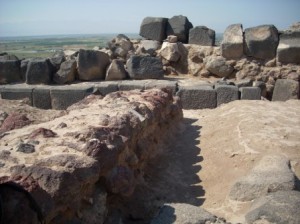Today, I got a personal tour of the Hellenistic-period capital city, Armavir. In the Urartian period (early 1st millennium BC), there was a large temple, whose foundation still stands. The city (which some have interpreted more as a sacred religious center than a true ‘city’) was still in use in the Achaemenid period (6th-4th centuries BC), and into the Hellenistic period (3rd-ca. 1st centuries BC). Then there was a gap in occupation until the Middle Ages, at which point many of the well-worked stones from the Urartian temple were redeployed in a different construction. It’s clear where the newer construction starts and where the older, Urartian construction lies next to it. Those folks in the Middle Ages didn’t bother fitting the worked stones together well, leaving an overall impression of rather sloppy construction.
The summit of the hill is very interesting, partly because of the multiple periods of use, which also include the Soviet period, when some sort of military blind was erected on the medieval construction. This year, the excavators are working to take down as much of that military construction as possible, in order to more completely expose the temple foundation. So to do that, the work involves a lot of demolition with pickaxes and an absolutely enormous prybar.
There are also some inscriptions at Armavir that are quite interesting, although they are on a rock at the base of the hill, on the southern face. More on those later.
Update: The medieval wall has been removed! It was a chapel, whose floor likely consisted of some flat paving stones that had been in the courtyard for the Urartian temple. Some of the paving stones have been found, and the wall was removed to facilitate the search for the extent of the courtyard.



Where did the people of the Urartian period come from?